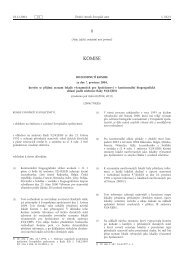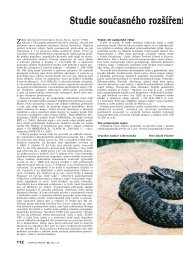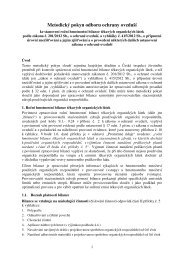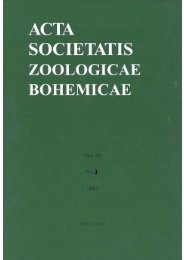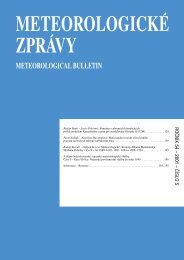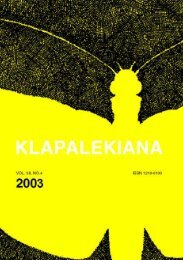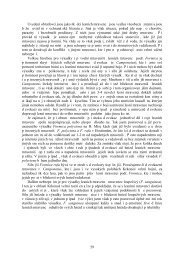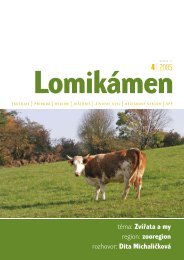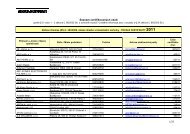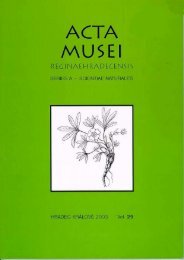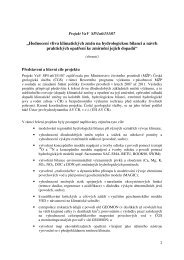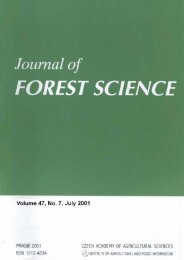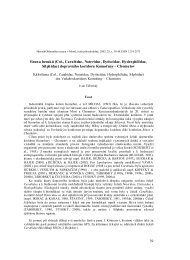Distribution and taxonomy of some Synapsis species, with ...
Distribution and taxonomy of some Synapsis species, with ...
Distribution and taxonomy of some Synapsis species, with ...
You also want an ePaper? Increase the reach of your titles
YUMPU automatically turns print PDFs into web optimized ePapers that Google loves.
The Branov site has a scree slope located on the north slope <strong>of</strong> the Berounka river valley, near the village <strong>of</strong><br />
Branov, 270 m a. s. l. (Fig. 2). This scree field is about 50 m broad <strong>and</strong> 20 m high. It consists <strong>of</strong> <strong>and</strong>esite stones<br />
about 15 cm in size on average, slope angle <strong>of</strong> 30–40°. The lower half <strong>of</strong> the scree slope is covered by a thick layer<br />
<strong>of</strong> vegetation. Saxifraga rosacea Moench <strong>and</strong> Festuca ovina L. predominate in the herb layer, Polytrichum<br />
juniperinum Hedw., Bartramia pomiformis Hedw., Ptilidium ciliare (L.) Ness, Dicranum polysetum Sw. <strong>and</strong><br />
Hylocomium splendens (Hedw.) Br. Eur. predominate in the moss layer (Klika 1941, Kolbek 1983). The scree<br />
field is surrounded by an Aceri-Carpinetum forest community.<br />
The scree field at Blansko-Skalní Mlýn is about 50 m broad <strong>and</strong> 30 m high, consists <strong>of</strong> limestone stones about<br />
15 cm in size on average, <strong>and</strong> has a slope angle <strong>of</strong> 40°. It is situated on the northwest slope <strong>of</strong> the Punkva river<br />
valley, 350 m a. s. l. The upper part <strong>of</strong> the field is bare, the lower third is overgrown <strong>with</strong> mixed forest, while the<br />
transition zone between forest <strong>and</strong> bare debris is covered <strong>with</strong> moss.<br />
Trapping<br />
The spiders were trapped in pitfall traps made <strong>of</strong> rigid plastic, about 13 cm high <strong>and</strong> 10.5 cm in diameter. Each trap<br />
consisted <strong>of</strong> a cylindrical can <strong>with</strong> a board fitted above the upper opening <strong>of</strong> the can (R%ži!ka 1982). The traps<br />
contained a water mixture <strong>of</strong> 7% formaldehyde <strong>and</strong> 10% glycerol <strong>with</strong> a few drops <strong>of</strong> a surfactant (R%ži!ka 1988).<br />
In the scree consisting <strong>of</strong> boulders 15 cm <strong>and</strong> more in size the traps were positioned in pits up to 1 m deep.<br />
However, in the scree consisting <strong>of</strong> stones less than 20 cm in size constructing a pit proved impossible as the sides<br />
<strong>of</strong> the pit collapsed during construction. Therefore, in the K&ivoklátsko Biosphere Reserve, a set <strong>of</strong> telescopic<br />
metal rings were used to prevent the walls <strong>of</strong> the pits from collapsing. Progressively smaller rings are inserted <strong>and</strong><br />
the stones removed to a perpendicular depth <strong>of</strong> 1 m into the scree. A perforated plastic tube was inserted close to<br />
the pit wall, enabling the temperature <strong>with</strong>in the scree to be measured throughout the year. The traps were<br />
installed <strong>and</strong> several stones placed on the board supporting the ro<strong>of</strong>. The free space was then filled <strong>with</strong> stones <strong>and</strong><br />
the rings removed (Fig. 3). Three traps were set in each pit, at depths <strong>of</strong> 100 cm, 70 cm, <strong>and</strong> 40 cm <strong>and</strong> one on<br />
the surface. Two sets <strong>of</strong> traps were installed at Tý&ov site, one on the upper <strong>and</strong> the other on the lower margin <strong>of</strong><br />
the scree field. One set <strong>of</strong> traps was installed on the lower margin <strong>of</strong> the slope at the Branov site. Max/min<br />
thermometers were used to measure the maximum <strong>and</strong> minimum temperatures experienced during the experiment<br />
at the surface <strong>and</strong> at the depth <strong>of</strong> 1 m. Daily changes in temperature inside the scree was measured on 8 August<br />
1994 using a digital thermometer. The whole experiment was started on 29 May 1994 <strong>and</strong> the traps were<br />
removed, <strong>and</strong> the experiment was terminated on 21 May 1995.<br />
Fig. 3. Cross-section through an probe inserted in the scree slopes. Telescopic metal rings share up the sides <strong>of</strong> the<br />
hollow in the scree, in which pitfall traps <strong>with</strong> preserving fluid, <strong>and</strong> a ro<strong>of</strong> are installed.<br />
322



